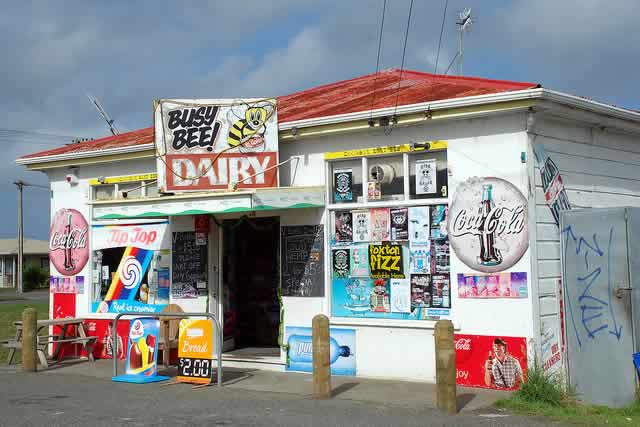The other day we tweeted a simple fact: Poor neighbourhoods have three times the number of takeaways and dairies around schools as rich neighbourhoods.
The reaction on social media was one of concern at this state of affairs and it also triggered quite a bit of debate on Facebook.
So we decided that with the local body elections underway it was timely to follow that up with a blog and survey on our local food environment.
As a bit of background, you need to know a few things. We humans are simple creatures and not as rational as we think. If we see food, we are more likely to eat it. The more convenient food is, the more we will eat. Most of the food decisions we make are subconscious – our rational brain doesn’t have enough time to veto what we shove in our gobs because our animal brains have already decided. For some people it is even possible to show that certain foods – particularly those that contain lot of sugar fat and salt – are addictive. We talk about all these issues much more in the book.
Once you get your head around these facts, it is easy to see that your eating environment has a huge impact on your waistline and health. That includes your home, your desk, and your neighbourhood. There are a couple of ways that your local environment matters; the placement of food outlets and opportunities for exercise.
We’ll start with the placement of food outlets. Remember, the more the temptation of sugary and fatty food is dangled before us, the more likely our willpower is likely to crack in a moment of weakness. Currently takeaways and dairies cluster around schools, particularly in the poorest neighbourhoods. In fact there are more fast food outlets and convenience stores (like dairies, whose sales overwhelmingly comprise pies, soft drinks and sweets) in poor areas generally. Primary schools seem to attract more stores, although secondary schools were surrounded by higher levels of unhealthy food advertisements. The upshot of this is that the average child in Auckland has to walk less than 350 metres from the school gate to the nearest dairy, and under 400 metres to the nearest fast food outlet. Given what we know about the impact of sugary, fatty and salty food on the developing brain, it is hard not to draw a comparison with drug lords targeting the youngest and most vulnerable members of our society to get them hooked. We also know that poor early eating habits set a kid up for a lifetime of struggles with their weight.
Currently local communities can’t do much about this. The Resource Management Act (RMA) ensures that each development assesses the environmental impact before proceeding, but there is no such consideration of health impact. Nor are there any minimum standards in terms of where peddlers of junk food can set up shop. A Health Impact Assessment (HIA) has been developed, which is encouraged for use in council planning processes, but it is voluntary to undertake and the findings are not binding. This is a glaring oversight in our current approach to planning and ultimately requires a change to the RMA. In the meantime you can vote for politicians that will push for HIA’s on major developments.
Now to opportunities for exercise. Sadly, our built-up environment is often not conducive to healthy eating or exercise, and it’s not easy to change. The more opportunities there are for exercise as part of our day, the better; whether that be cycling to school or work, walking to the dairy for the paper or climbing a tree to woo the girl next door. This sort of exercise (the kind that is built into our routine, like travelling to work) has a bigger impact on our health than going to the gym. The trouble is that modern life has designed out many of these things in the name of speed, safety or laziness. We want a big house in the suburbs and need to use the car to get around. Unlike compact European cities which are walking-, cycling- and public transport-friendly, we have sprawling cities full of roundabouts. This makes active transport (cycling and walking) more expensive to set up, people are reluctant to switch to it when it is there, and no one wants to pay for it. It’s a Catch-22: people won’t give up their cars until the active or public transport is decent, but in the meantime they are spending too much on their three family cars to invest in public transport. As a result, only 7% of Kiwis walk to work and 2.5% cycle – far less than in European countries. For kids under 15, the figure is higher (at around half), but that still means half of our kids are either getting to school by bus or, more likely, in the back of the parents’ SUV. And we pride ourselves on our rugged interactivity with the ‘Great Outdoors’: it’s a myth.
In short, planning needs to take account of the wider impacts of this car culture and the ‘convenient’ placement of food outlets on our health and environment. Investment is needed in providing realistic public transport and to make walking and cycling a viable and vital part of our daily round. And it’s not just a matter of throwing money and design at infrastructure: the cities that have successfully made the transition have changed attitudes to public transport, cycling and walking. Basically, young people need to think helmet hair is sexy. But this investment isn’t going to happen until people demand it. Rising petrol prices and the Emissions Trading Scheme will help, as would congestion charging in city centres – the London scheme has resulted in more people using active and public transport. In the mean time you can vote for candidates that will make active transport easier and safer. Generation Zero have reviewed candidates policies on cycling here:http://localelections.generationzero.org.nz/

